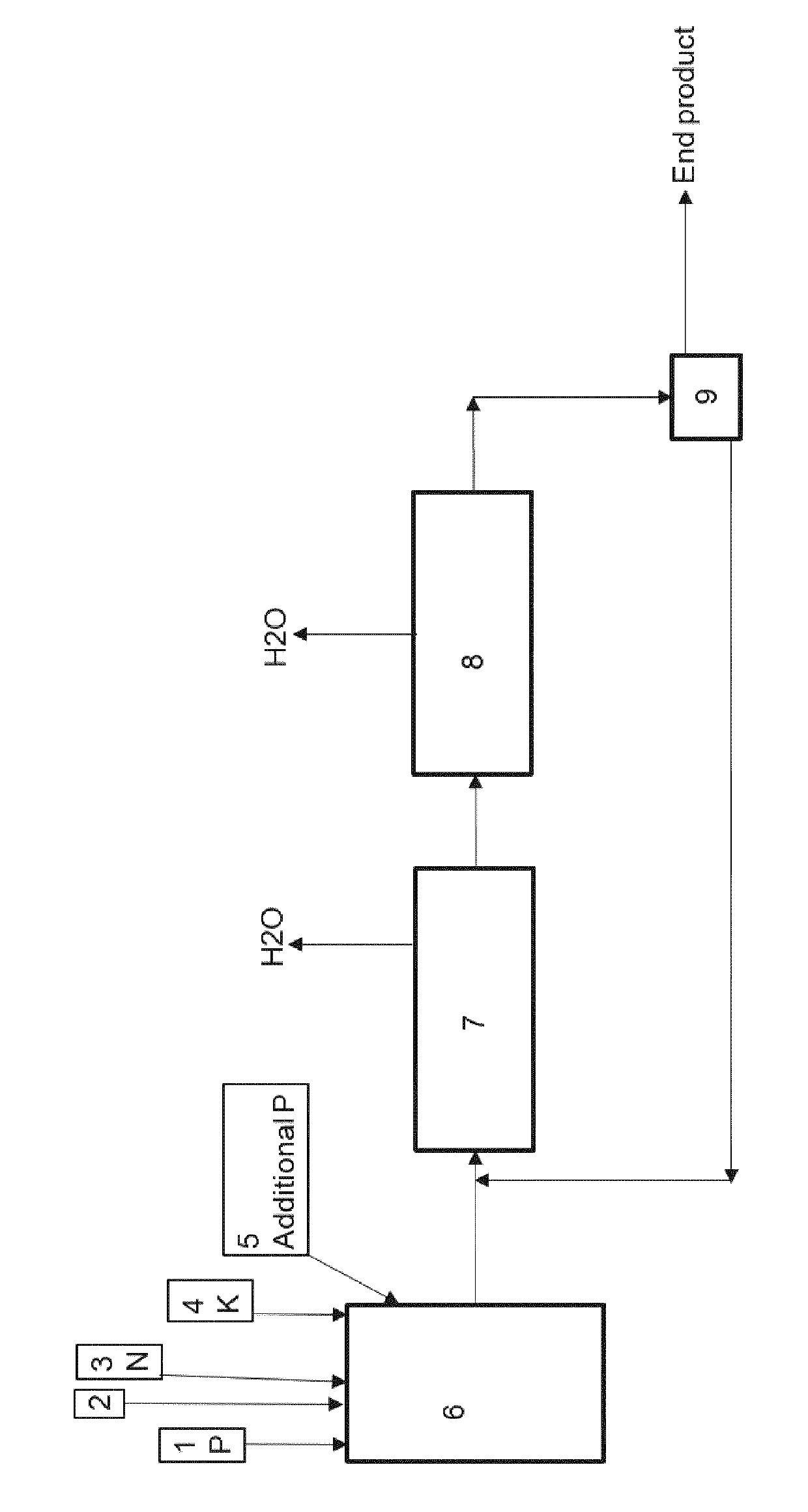Production of a phosphate containing fertilizer
- Summary
- Abstract
- Description
- Claims
- Application Information
AI Technical Summary
Benefits of technology
Problems solved by technology
Method used
Image
Examples
example 1
[0082]The phosphorus recovery in the tertiary treatment was simulated in the laboratory scale using wastewater from a wastewater treatment plant having a biological treatment process. As the wastewater treatment practices today require the removal of phosphorus, the total phosphorus in the wastewater was reduced to meet these requirements at the plant, to below 0.3 mgP / l. Thus the phosphorus level was first raised to the desired level using Na3PO4.
[0083]52.93 grams of Na3PO4 was dissolved into one liter of water. 1000 liters of wastewater was taken from the process and placed in a 1 m3 IBC-container that was equipped with a motor stirrer. Stirring was turned on and the prepared Na3PO4-solution was added into the mixing wastewater to raise the phosphorus level to 10 mgP / l. 241.7 g of PIX-111 (Fe 13.8%, density 1.42 g / ml) was fast added pouring from a bottle into a well-mixed container. Mixing was continued for 10 seconds after the PIX-111 addition, where after it was stopped. Precipi...
example 2
[0092]The obtained dewatered phosphate precipitate, FePO4 precipitate, is mixed with urea (nitrogen source) and potassium chloride (potassium source) to produce a NPK-fertilizer. The following components and amounts are mixed: 300.0 g of urea (46.0 wt % N), 300.0 g of KCl (60 wt % K2O=49.8 wt % K), and 3000.0 g of FePO4 dewatered cake (9.0 wt % P of DS=20.6 wt % P2O5 of DS, and 90 wt % H2O). The N, P2O5 and K2O amounts in the final fertilizer on dry solid basis are 15.33 wt % N, 6.88 wt % P2O5 and 20.00 wt % K2O. This slurry mixture contains 75% of H2O and can be used as such as a slurry fertilizer. The N, P2O5 and K2O amounts in this slurry fertilizer are 3.83 wt % N, 1.72 wt % P2O5 and 5.00 wt % K2O.
[0093]Optionally the slurry can be fed into the granulator to produce a granulated fertilizer product and even further into the dryer to evaporate more water to produce granular, dried fertilizer product. Drying can be applied alone also without granulating. Optionally the granules can...
example 3
[0095]The obtained dewatered phosphate precipitate, FePO4 precipitate is mixed with urea (nitrogen source), diammonium phosphate (nitrogen and start phosphorus source) and potassium chloride (potassium source) to produce a NPK-fertilizer. The following components and amounts are mixed: 291.5 g of urea (46.0 wt % N), 301.0 g of KCl (60 wt % K2O=49.8 wt % K), 2000.0 g of FePO4 dewatered cake (9.0 wt % P of DS=20.6 wt % P2O5 of DS, and 85 wt % H2O) and 258.0 g of (NH4)2HPO4 (46 wt % P2O5=20.1 wt % P, 18.0 wt % N). The N, P2O5 and K2O amounts in the final fertilizer on dry solid basis are 15.69 wt % N, 15.69 wt % P2O5 and 15.70 wt % K2O. This slurry mixture contains 59.64% of H2O and can be used as such as a slurry fertilizer. The N, P2O5 and K2O amounts in this slurry fertilizer are 6.33 wt % N, 6.33 wt % P2O5 and 6.34 wt % K2O.
[0096]Optionally the slurry can be fed into the granulator to produce a granulated fertilizer product and even further into the dryer to evaporate more water to...
PUM
 Login to View More
Login to View More Abstract
Description
Claims
Application Information
 Login to View More
Login to View More - R&D
- Intellectual Property
- Life Sciences
- Materials
- Tech Scout
- Unparalleled Data Quality
- Higher Quality Content
- 60% Fewer Hallucinations
Browse by: Latest US Patents, China's latest patents, Technical Efficacy Thesaurus, Application Domain, Technology Topic, Popular Technical Reports.
© 2025 PatSnap. All rights reserved.Legal|Privacy policy|Modern Slavery Act Transparency Statement|Sitemap|About US| Contact US: help@patsnap.com

